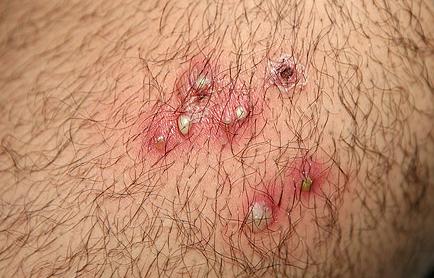Folliculitis Definition Symptoms and Treatment
What is folliculitis caused by?
Folliculitis is a bacterial dermatological infection of the hair follicles that is usually caused by s. aureus. Less commonly, Folliculitis can be caused by p. aeruginosa. It is characterized by an inflammatory nodule or superficial pustule surrounding the hair follicle. Moreover, folliculitis may follow or accompany other pyodermas as well as it can affect the superficial or deep layers of the skin.
Can folliculitis spread from person to person?
Folliculitis may be transmitted from person to person through skin contact because the causative pathogens of folliculitis are contagious.
Symptoms
What are the symptoms of folliculitis?
Folliculitis is characterized by clusters of small red bumps and white-headed pimples (pus-filled pimples) that appear about 72 hours after you’ve been in a spa. Most often, these pimples develop around hair follicles on your stomach, arms and legs.
When the pus-filled pimples break open, they drain pus and blood.
Ongoing low-grade fever as well as irritation or inflammation without a significant infection maybe noticed especially when stiff hairs in the bearded area emerge from the follicle, curve and reenter the skin (ingrown hair).
Do ingrown hair bumps go away on their own and how long does folliculitis last?
Ingrown hairs often go away on their own. Mild cases of folliculitis usually resolve spontaneously in 7 to 10 days. However, conservative medical treatment may be needed in severe cases.
Patients suffering of folliculitis can remove the infected hairs easily, and if left untreated the condition may worsen and new papules may develop.
Folliculitis may develop into a chronic disease especially in hairy people, where the hair follicles are numerous and/or deep in the skin, as in the bearded area of men (sycosis barbae).
Treatment
What is the best treatment for folliculitis?
In most cases, folliculitis goes away on its own in 7 -10 days.
How to treat folliculitis?
Systemic treatment of acute Folliculitis is similar to the treatment of other diseases caused by bacterial infections such as impetigo, a classical treatment composed of topical antibiotics and antiseptics such as chlorhexidine are usually useful.
Indomethacin is a nonsteroidal anti-inflammatory drug (NSAID) used to treat aches and swelling. it is usually dosed 2 times per day and starts at a dose of 25 mg (50 mg/day) orally.
What antibiotic is used to treat folliculitis?
Prompt treatment with systemic antibiotics may prevent chronic infection.
Oral Antibiotics such as dicloxacillin, levofloxacin, cephalexin, amoxicillin, minocycline, etc. are used for managing bacterial folliculitis.
Prevention of folliculitis
How to prevent folliculitis?
Take the following steps in order to prevent folliculitis:
- Maintain proper hygiene to minimize your risk of infection and also enhance your overall health, shower regularly, wash your hands often with antibacterial soap, trim your nails (keep fingernails dry and clean) and change your bedding and towels frequently.
- Stick to a sleep schedule, go to be and try to sleep tight.
- Wear loose, clean clothes everyday.
- Clean your razor with boiling water, and when shaving, take care not to cut your skin.
Verified by: Dr.Diab (July 3, 2018)
Citation: Dr.Diab. (July 3, 2018). What is Folliculitis? Definition Symptoms and Treatment. Medcoi Journal of Medicine, 8(2). urn:medcoi:article15612.














There are no comments yet
Or use one of these social networks